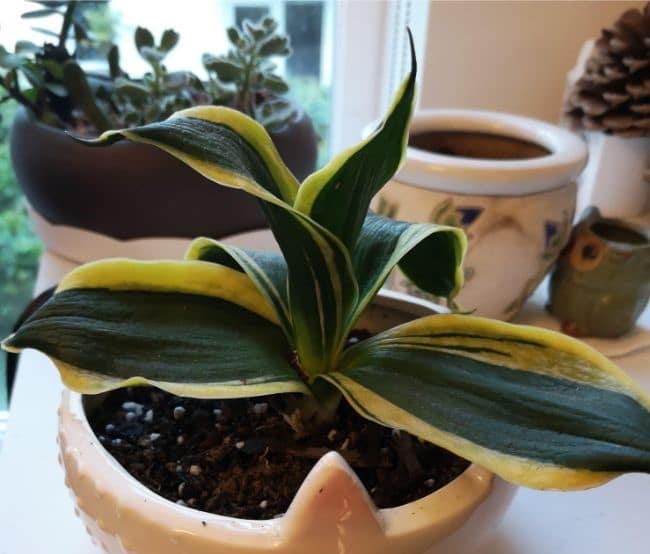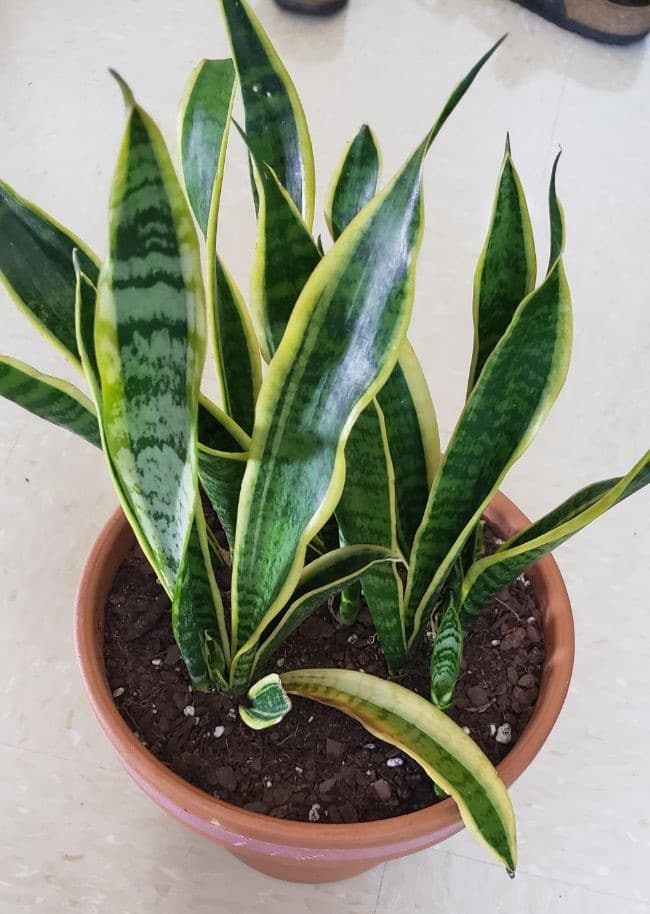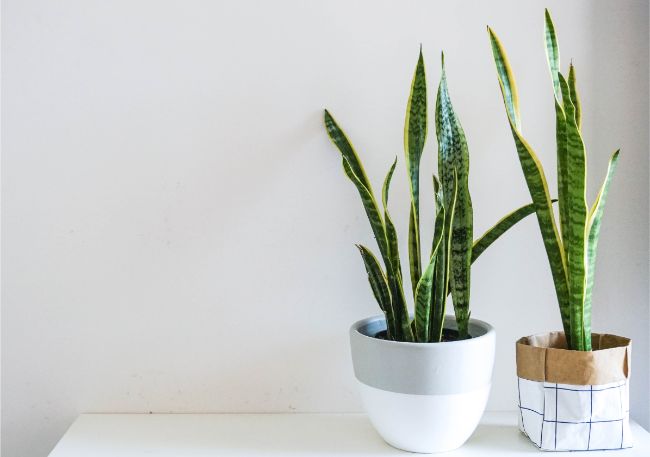Snake plant, or mother-in-law’s tongue (Sansevieria trifasciata) is known as a particularly tough houseplant, tolerating neglect of watering, feeding, and low light. This is good news if you find your snake plant drooping, as it’s usually an easy fix.
Why is your snake plant drooping? The most common reasons are overwatering, inadequate soil drainage, lack of heat, pests or disease, poor lighting or from being rootbound. Identifying and fixing the underlying problem will allow your plant to recover.
Read on and you’ll become an expert in creating the perfect conditions for your snake plant to reverse its drooping leaves and ensure it never happens again. If you’d like to really understand how to keep all of your houseplants healthy, check out my book, Houseplants Made Easy.
Why Is My Snake Plant Drooping?
There are 6 main reasons why snake plant leaves droop. By far the most common reasons are overwatering and poor drainage, so I’ll cover these first.
1. Overwatering And Root Rot
Snake plant is a succulent, which means its rubbery, thick leaves hold moisture exceptionally well. Most succulents need less watering than your typical houseplant and the snake plant is no exception, normally thriving in hot, dry areas of the West African tropics.
This means they can be easy to overwater, becoming susceptible to root rot if they receive too much moisture.
To get your snake plant back to its former glory, first let its soil dry out completely. Poke your finger deep into the soil to make sure it’s not just the surface that’s dry.
From that point on, allow the plant to dry completely between all waterings, with at least the top three inches of soil becoming completely dry.
To kill any potential root fungus, water only with 3% hydrogen peroxide for about three months. In severe cases of root rot, you may need to repot the plant (see below tip), removing any mushy or dead roots.
Usually snake plants require watering only once every two to four weeks, with plants that receive more light or heat needing watering more often. In the winter months they can be watered even less, only requiring water when the leaves look a bit wilted.
Watering can be one of the hardest skills to master when looking after houseplants. I’ve written an article which will show you how to tell when to water your houseplants.
2. Inadequate Soil And Drainage

If your watering regime seems to be in check, it could be that the soil is simply holding too much water and doesn’t have adequate drainage.
To fix this, repot your plant in potting mix for cacti or succulents. This is a great potting mix for your Snake plant that I have used many times with great success. Alternatively, simply add about half perlite to regular potting soil along with a bit of compost for fertility.
When repotting, remove as much of the existing soil as you can and ensure that you use a large enough pot (see below). One way to tell if soil isn’t well drained enough is that when you water, you should immediately see water coming out the bottom drainage holes.
If the soil is absorbing a lot of water even after you’ve poured a cup or so in, this is usually a sign that you need better drainage.
3. Root Bound: Repotting And/Or Root Trimming Needed
One of the most common problems with houseplants is that they become rootbound without occasional repotting or root trimming. Although snake plants don’t require repotting as often as other plants and will be fine rootbound to some extent, when it gets really bad they may become unhealthy and droop.
Even snake plants require soil for their roots to get the nutrients and water they need. Very tightly bound roots can also lead to girdling (the roots strangle themselves), rot and other disease issues and can prevent the plant from “breathing” properly (plant roots need air too!).
Snake plants require repotting every three to five years, or if you absolutely can’t put the plant in a bigger pot for whatever reason, you’ll need to trim the roots instead to make sure they take up only about half to three quarters of the space at most in the pot.
You can tell if a plant requires repotting or trimming by loosening the soil away from the sides with your fingers, checking to see if the roots of the plant are thick all the way to the sides of the pot. If there seems to be more root than soil, it’s time to move to a pot one size larger.
If the root ball is completely solid, you may need to tease the roots apart until they form a nice branching pattern rather than a clump before repotting.
To trim the roots (whether for putting back in the same pot, or to fix a constricted root ball before repotting) remove the plant and lay it carefully on its side. You’ll need a sharp pair of scissors or even a knife, which you’ll use to cut the roots one at a time.
Instead of simply carving the mass into a smaller root ball, carefully tease the roots apart, trimming entire chunks of root off where needed until the root system has room to move and branches outward. The goal is to break up the clump of roots to make it look more like how you would envision a normal root mass. Refer to the previous tip for potting mix requirements.

4. Temperature Issues: Lack Of Heat
Although it’s possible that a snake plant can get too hot, it’s unlikely this is your issue if the leaves are drooping. More than likely it isn’t receiving enough heat. For a healthy plant, keep temperatures above 50°F.
Keep in mind too that even when it’s warm in your house, if it’s cold outside the temperature by the window may be cooler. In this case look for a place where you can put the plant closer to a heat source or a bit further from the window.
5. Poor Lighting Can Cause Snake PLant Leaves To Droop
It is true that snake plants can handle shade well. However, they do much better in partial sun. If your plant is getting barely any light, it is possible this could be making it unhealthy and causing it to droop.
Besides the health reasons for ensuring adequate lighting, partial sun also tends to make snake plants look better, with brighter leaves that see their signature pattern popping out more. Although they can tolerate up to 8 hours or more of light per day, all-day direct light in a south-facing window may be too much for snake plants, however, also causing their leaves to droop.
Ideally, put the plant about 10 feet away from a south-facing window or in a sunny west or east facing window. Since western sun can be more intense, a west-facing plant will do better a few feet away from the window as well.
If moving the plant from an unlit area into a sunnier position, make sure to gradually expose the plant to the light, putting it in the sun for only a couple of hours at first and then adding an hour or so per day until it gets the full amount of sun at its new location.
Alternatively, you can use curtains, sticks, or other obstacles to partially block the sun, gradually exposing the plant to more and more light each day without needing to move it around.
6. Pests
Often if your snake plant has one of the above problems, this can weaken it and make it susceptible to pests.
For example, fungus gnats (fruit fly-like insects that come out of the soil from their larval form) may attack your plant if it is overwatered and/or has poor drainage. In this case, you may need to repot the plant in new soil, cut off rotten roots, and follow the watering and drainage tips above. Then, water with 3% hydrogen peroxide and an insecticide.
A good homemade option is 1 tablespoon of mild dish soap or Dr. Bronner’s, 1 tablespoon oil (e.g. sunflower or olive), and 15 drops of neem oil with 1 cup water. In extreme, persistent infestations, you may need to treat with pyrethrin-based insecticides.
Other rare snake plant pests include spider mites and mealybugs, though usually these will be obvious before the leaves begin to droop, as the plants will display tiny brown specks and/or faded dots on their leaves before drooping or shedding their leaves completely. Treat by spraying with an insecticide as above.
If you’re struggling to get rid of pests on your houseplants, read my article about some of the best ways to get rid of houseplant bugs naturally.

How To Fix Drooping Snake Plant Leaves
Depending on how bad your snake plant leaves are drooping, you may be able to revive them to some extent by following the tips above. However, if they are in bad shape, you probably can’t do anything to fix the existing leaves. Your options are to leave them alone until new, upright growth begins, and then cut them off, or simply let them be until they die on their own as new growth takes over.
Rotten or dead leaves should be cut off to just below the dead or rotten part. Keep in mind that the tips of these cut leaves will never regrow. Be careful not to cut too much of the leaf mass off, as this may cause the plant to die, without enough light being photosynthesized to allow it to grow.
It’s best to wait for new, healthy growth to come in before cutting off the old leaves, as this will ensure your plant will be back to full health much sooner.
Follow the above tips for bringing your drooping snake plant back to health and you shouldn’t have problems with it ever again.
If you’ve ever been left disappointed when one of your houseplants got sick or died, and you weren’t too sure what happened, then I can help you. My book, Houseplants Made Easy, explains how to really understand what your houseplants need and how to care for them to keep them thriving.
If you’d like to read more about Snake Plant care, and how to deal with common problems, here are some other articles you may be interested in.

